Motivation Techniques at Jack Stores: A Detailed Report Analysis
VerifiedAdded on 2023/01/16
|8
|1642
|88
Report
AI Summary
This report delves into the application of motivation techniques at Jack Stores, a discount store launched by Tesco. It examines two prominent motivational theories: Maslow's Hierarchy of Needs and Herzberg's Two-Factor Theory. The report analyzes how these theories can be utilized to enhance employee retention and productivity, crucial for the success of Jack Stores in a competitive market. Maslow's theory is discussed in detail, outlining how fulfilling psychological, safety, social, esteem, and self-actualization needs can motivate employees. The report also explores Herzberg's theory, differentiating between hygiene and motivational factors and their impact on employee satisfaction and performance. The conclusion emphasizes the importance of motivation in improving employee morale and overall organizational success, providing insights into the practical application of these theories within the context of Jack Stores' operations.
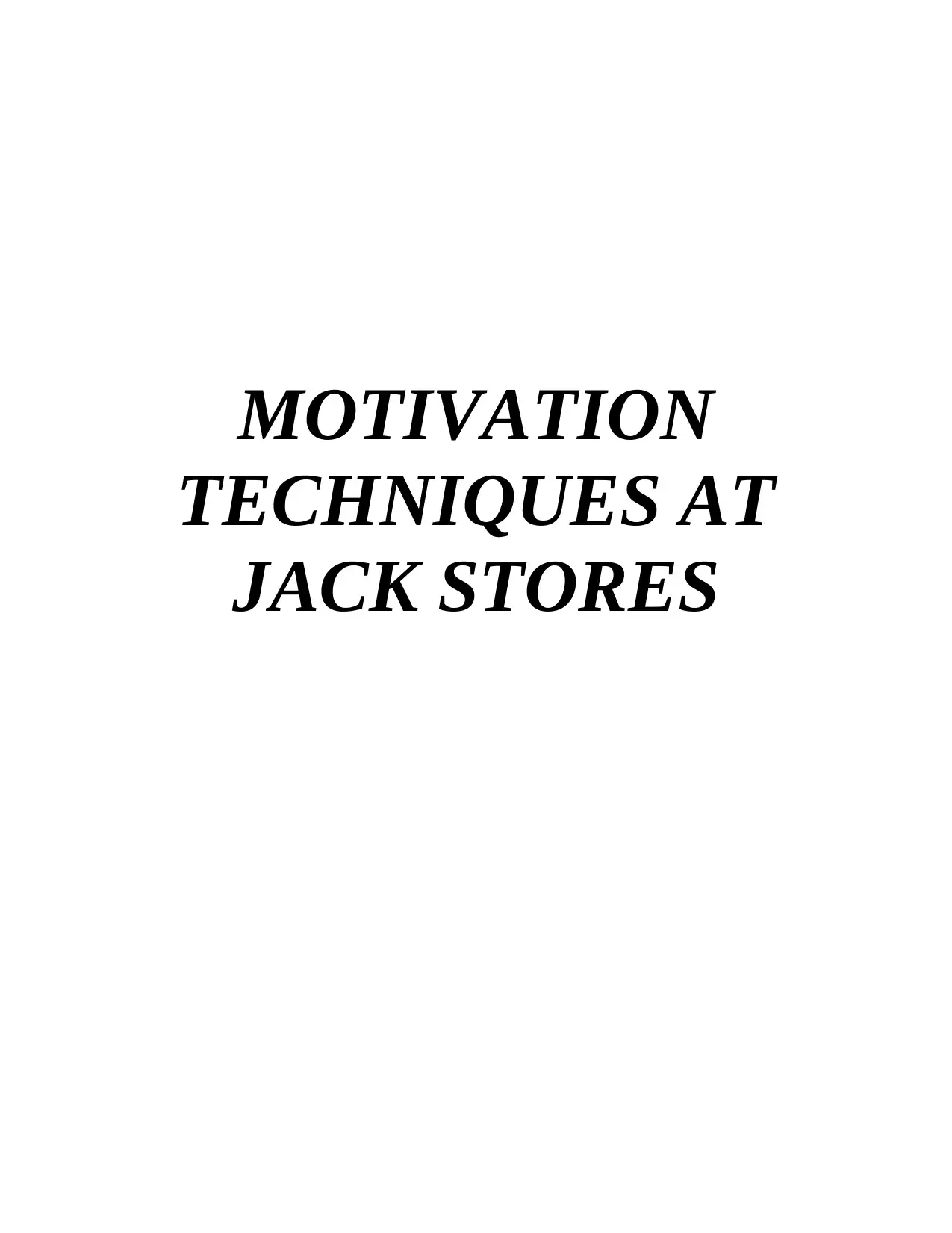
MOTIVATION
TECHNIQUES AT
JACK STORES
TECHNIQUES AT
JACK STORES
Paraphrase This Document
Need a fresh take? Get an instant paraphrase of this document with our AI Paraphraser

Table of Contents
INTRODUCTION...........................................................................................................................1
MOTIOVATIONAL THEORIES...................................................................................................1
Maslow's Hierarchy of Needs.....................................................................................................1
Herzberg's Two-Factor Theory...................................................................................................3
CONCLUSION................................................................................................................................3
REFERENCES................................................................................................................................5
INTRODUCTION...........................................................................................................................1
MOTIOVATIONAL THEORIES...................................................................................................1
Maslow's Hierarchy of Needs.....................................................................................................1
Herzberg's Two-Factor Theory...................................................................................................3
CONCLUSION................................................................................................................................3
REFERENCES................................................................................................................................5

INTRODUCTION
Motivation is derived from the word “motive” which represent needs and desires of
individuals. It defines the procedure which stimulate the actions of individuals to the
accomplishment of goals. Motivation is the psychological phenomenon which is classified under
three stages such as feeling of need, stimulus in which need arises and lastly satisfaction for
accomplishment of needs. It can be done by two ways first one is internal and second is external.
Internal includes the inner urge and external is done by the manager or leader which motivate the
employees to achieve goals. (Kearney, 2018). In this report, motivational theories are used for
Jack Stores to retain and improve productivity of its employees. Jack Store is opened by TESCO
against its rivals like Aldi and Lidl. It is the discount store and named on the TESCO's founder,
Jack Cohen. Many research shows that an individual can motivate themselves with the help of
self control. In this report motivational theories are discussed with its advantages and
disadvantages and based on the aspects of HR to motivate an individual.
MOTIOVATIONAL THEORIES
There are many theories of motivation which impacts the result of performance of
employees and these theories are used to define the needs and requirements of employees and
how they can be fulfilled (Nurmi and et. al., 2016). Motivation is the factor or element which
motivates the performance of employees. It is useful for the manager of Jack Stores to retain
their employees and improve their productivity and for this, rewards are the primary element as it
is helpful in the retention of employees in an organisation. This process is performed by the
managers and leaders of Jack Store to make challenging tasks easy for their workforce and for
this, two motivational theories are mentioned as under:
Maslow's Hierarchy of Needs
This theory is considered as the most well and used theory to motivate employees as it
describe the basic human needs in a hierarchical manner which is low to high (Teixeira and
Hagger, 2016). Maslow believe that once a need is satisfied then it is no longer used to motivate
an individual. These needs are classified under five parts which are discussed as:
1
Motivation is derived from the word “motive” which represent needs and desires of
individuals. It defines the procedure which stimulate the actions of individuals to the
accomplishment of goals. Motivation is the psychological phenomenon which is classified under
three stages such as feeling of need, stimulus in which need arises and lastly satisfaction for
accomplishment of needs. It can be done by two ways first one is internal and second is external.
Internal includes the inner urge and external is done by the manager or leader which motivate the
employees to achieve goals. (Kearney, 2018). In this report, motivational theories are used for
Jack Stores to retain and improve productivity of its employees. Jack Store is opened by TESCO
against its rivals like Aldi and Lidl. It is the discount store and named on the TESCO's founder,
Jack Cohen. Many research shows that an individual can motivate themselves with the help of
self control. In this report motivational theories are discussed with its advantages and
disadvantages and based on the aspects of HR to motivate an individual.
MOTIOVATIONAL THEORIES
There are many theories of motivation which impacts the result of performance of
employees and these theories are used to define the needs and requirements of employees and
how they can be fulfilled (Nurmi and et. al., 2016). Motivation is the factor or element which
motivates the performance of employees. It is useful for the manager of Jack Stores to retain
their employees and improve their productivity and for this, rewards are the primary element as it
is helpful in the retention of employees in an organisation. This process is performed by the
managers and leaders of Jack Store to make challenging tasks easy for their workforce and for
this, two motivational theories are mentioned as under:
Maslow's Hierarchy of Needs
This theory is considered as the most well and used theory to motivate employees as it
describe the basic human needs in a hierarchical manner which is low to high (Teixeira and
Hagger, 2016). Maslow believe that once a need is satisfied then it is no longer used to motivate
an individual. These needs are classified under five parts which are discussed as:
1
⊘ This is a preview!⊘
Do you want full access?
Subscribe today to unlock all pages.

Trusted by 1+ million students worldwide
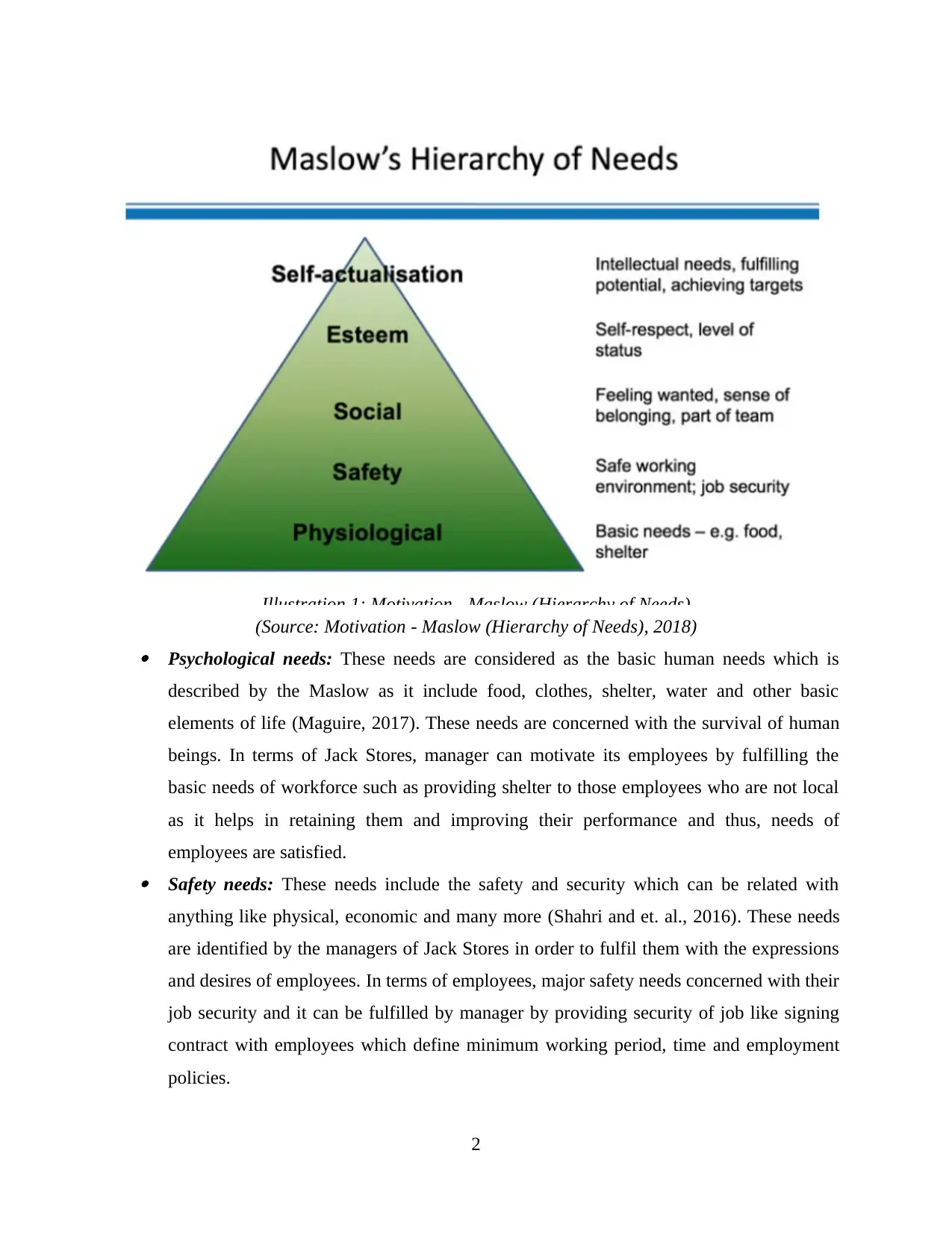
Illustration 1: Motivation - Maslow (Hierarchy of Needs)
(Source: Motivation - Maslow (Hierarchy of Needs), 2018) Psychological needs: These needs are considered as the basic human needs which is
described by the Maslow as it include food, clothes, shelter, water and other basic
elements of life (Maguire, 2017). These needs are concerned with the survival of human
beings. In terms of Jack Stores, manager can motivate its employees by fulfilling the
basic needs of workforce such as providing shelter to those employees who are not local
as it helps in retaining them and improving their performance and thus, needs of
employees are satisfied. Safety needs: These needs include the safety and security which can be related with
anything like physical, economic and many more (Shahri and et. al., 2016). These needs
are identified by the managers of Jack Stores in order to fulfil them with the expressions
and desires of employees. In terms of employees, major safety needs concerned with their
job security and it can be fulfilled by manager by providing security of job like signing
contract with employees which define minimum working period, time and employment
policies.
2
(Source: Motivation - Maslow (Hierarchy of Needs), 2018) Psychological needs: These needs are considered as the basic human needs which is
described by the Maslow as it include food, clothes, shelter, water and other basic
elements of life (Maguire, 2017). These needs are concerned with the survival of human
beings. In terms of Jack Stores, manager can motivate its employees by fulfilling the
basic needs of workforce such as providing shelter to those employees who are not local
as it helps in retaining them and improving their performance and thus, needs of
employees are satisfied. Safety needs: These needs include the safety and security which can be related with
anything like physical, economic and many more (Shahri and et. al., 2016). These needs
are identified by the managers of Jack Stores in order to fulfil them with the expressions
and desires of employees. In terms of employees, major safety needs concerned with their
job security and it can be fulfilled by manager by providing security of job like signing
contract with employees which define minimum working period, time and employment
policies.
2
Paraphrase This Document
Need a fresh take? Get an instant paraphrase of this document with our AI Paraphraser
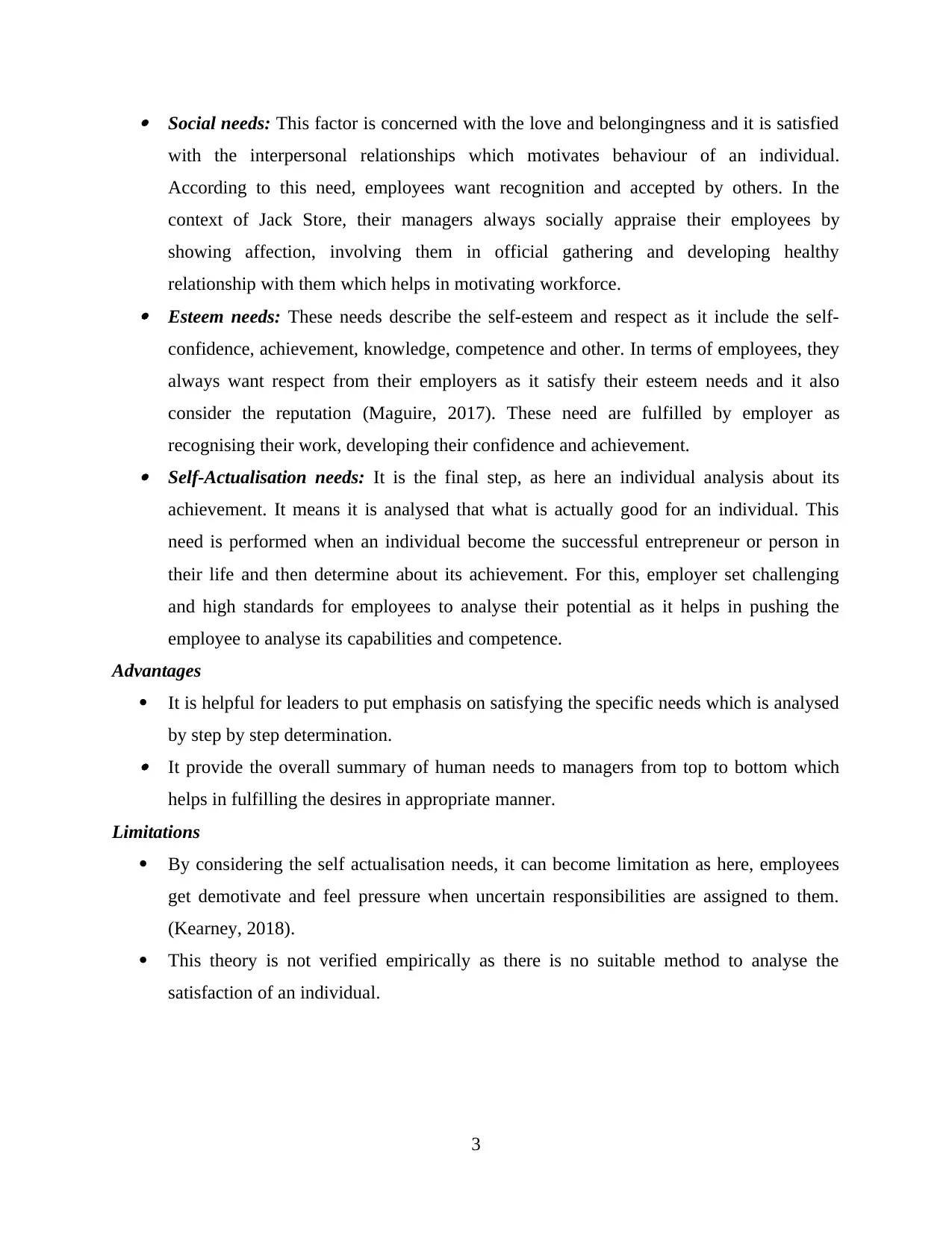
Social needs: This factor is concerned with the love and belongingness and it is satisfied
with the interpersonal relationships which motivates behaviour of an individual.
According to this need, employees want recognition and accepted by others. In the
context of Jack Store, their managers always socially appraise their employees by
showing affection, involving them in official gathering and developing healthy
relationship with them which helps in motivating workforce. Esteem needs: These needs describe the self-esteem and respect as it include the self-
confidence, achievement, knowledge, competence and other. In terms of employees, they
always want respect from their employers as it satisfy their esteem needs and it also
consider the reputation (Maguire, 2017). These need are fulfilled by employer as
recognising their work, developing their confidence and achievement. Self-Actualisation needs: It is the final step, as here an individual analysis about its
achievement. It means it is analysed that what is actually good for an individual. This
need is performed when an individual become the successful entrepreneur or person in
their life and then determine about its achievement. For this, employer set challenging
and high standards for employees to analyse their potential as it helps in pushing the
employee to analyse its capabilities and competence.
Advantages
It is helpful for leaders to put emphasis on satisfying the specific needs which is analysed
by step by step determination. It provide the overall summary of human needs to managers from top to bottom which
helps in fulfilling the desires in appropriate manner.
Limitations
By considering the self actualisation needs, it can become limitation as here, employees
get demotivate and feel pressure when uncertain responsibilities are assigned to them.
(Kearney, 2018).
This theory is not verified empirically as there is no suitable method to analyse the
satisfaction of an individual.
3
with the interpersonal relationships which motivates behaviour of an individual.
According to this need, employees want recognition and accepted by others. In the
context of Jack Store, their managers always socially appraise their employees by
showing affection, involving them in official gathering and developing healthy
relationship with them which helps in motivating workforce. Esteem needs: These needs describe the self-esteem and respect as it include the self-
confidence, achievement, knowledge, competence and other. In terms of employees, they
always want respect from their employers as it satisfy their esteem needs and it also
consider the reputation (Maguire, 2017). These need are fulfilled by employer as
recognising their work, developing their confidence and achievement. Self-Actualisation needs: It is the final step, as here an individual analysis about its
achievement. It means it is analysed that what is actually good for an individual. This
need is performed when an individual become the successful entrepreneur or person in
their life and then determine about its achievement. For this, employer set challenging
and high standards for employees to analyse their potential as it helps in pushing the
employee to analyse its capabilities and competence.
Advantages
It is helpful for leaders to put emphasis on satisfying the specific needs which is analysed
by step by step determination. It provide the overall summary of human needs to managers from top to bottom which
helps in fulfilling the desires in appropriate manner.
Limitations
By considering the self actualisation needs, it can become limitation as here, employees
get demotivate and feel pressure when uncertain responsibilities are assigned to them.
(Kearney, 2018).
This theory is not verified empirically as there is no suitable method to analyse the
satisfaction of an individual.
3
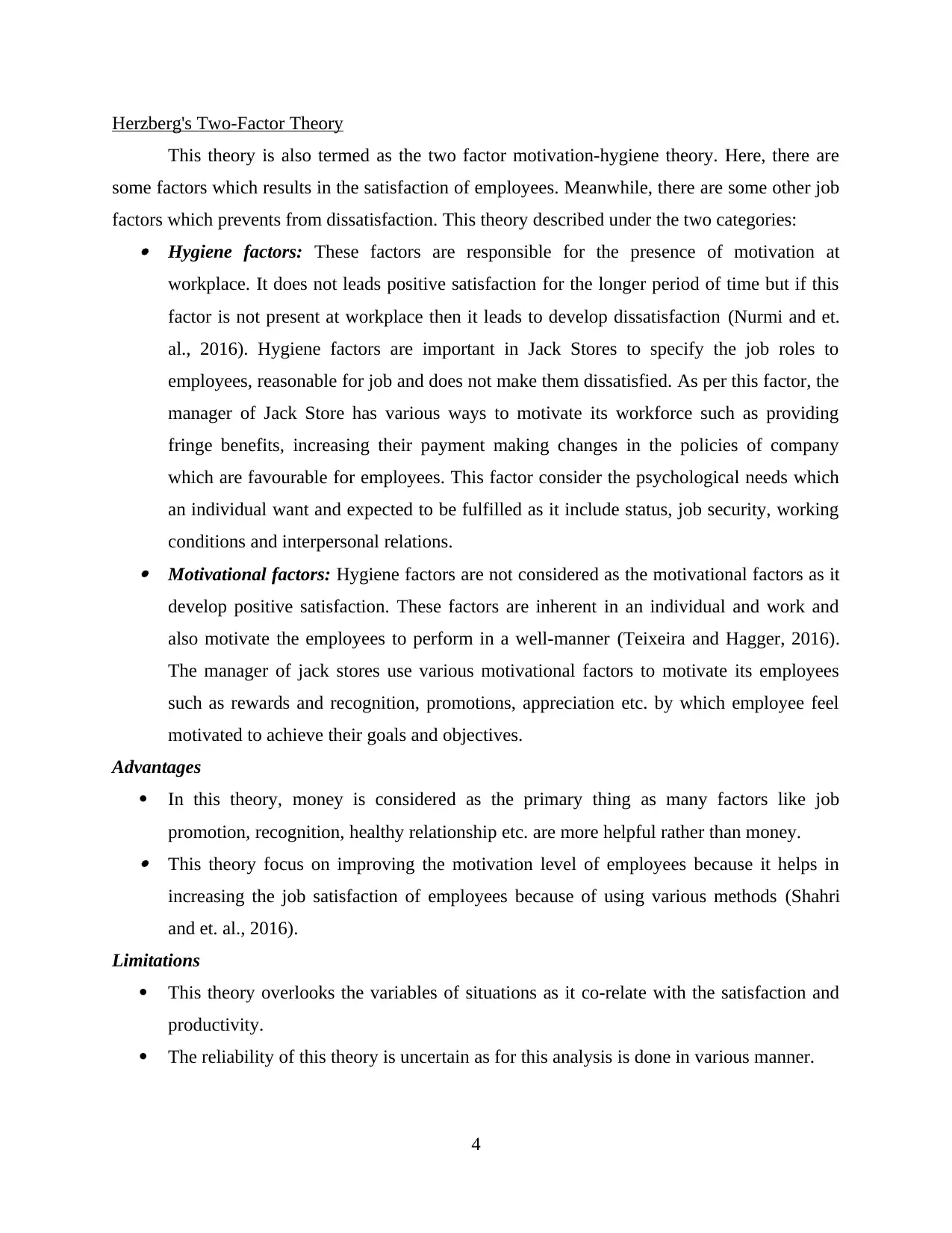
Herzberg's Two-Factor Theory
This theory is also termed as the two factor motivation-hygiene theory. Here, there are
some factors which results in the satisfaction of employees. Meanwhile, there are some other job
factors which prevents from dissatisfaction. This theory described under the two categories: Hygiene factors: These factors are responsible for the presence of motivation at
workplace. It does not leads positive satisfaction for the longer period of time but if this
factor is not present at workplace then it leads to develop dissatisfaction (Nurmi and et.
al., 2016). Hygiene factors are important in Jack Stores to specify the job roles to
employees, reasonable for job and does not make them dissatisfied. As per this factor, the
manager of Jack Store has various ways to motivate its workforce such as providing
fringe benefits, increasing their payment making changes in the policies of company
which are favourable for employees. This factor consider the psychological needs which
an individual want and expected to be fulfilled as it include status, job security, working
conditions and interpersonal relations. Motivational factors: Hygiene factors are not considered as the motivational factors as it
develop positive satisfaction. These factors are inherent in an individual and work and
also motivate the employees to perform in a well-manner (Teixeira and Hagger, 2016).
The manager of jack stores use various motivational factors to motivate its employees
such as rewards and recognition, promotions, appreciation etc. by which employee feel
motivated to achieve their goals and objectives.
Advantages
In this theory, money is considered as the primary thing as many factors like job
promotion, recognition, healthy relationship etc. are more helpful rather than money. This theory focus on improving the motivation level of employees because it helps in
increasing the job satisfaction of employees because of using various methods (Shahri
and et. al., 2016).
Limitations
This theory overlooks the variables of situations as it co-relate with the satisfaction and
productivity.
The reliability of this theory is uncertain as for this analysis is done in various manner.
4
This theory is also termed as the two factor motivation-hygiene theory. Here, there are
some factors which results in the satisfaction of employees. Meanwhile, there are some other job
factors which prevents from dissatisfaction. This theory described under the two categories: Hygiene factors: These factors are responsible for the presence of motivation at
workplace. It does not leads positive satisfaction for the longer period of time but if this
factor is not present at workplace then it leads to develop dissatisfaction (Nurmi and et.
al., 2016). Hygiene factors are important in Jack Stores to specify the job roles to
employees, reasonable for job and does not make them dissatisfied. As per this factor, the
manager of Jack Store has various ways to motivate its workforce such as providing
fringe benefits, increasing their payment making changes in the policies of company
which are favourable for employees. This factor consider the psychological needs which
an individual want and expected to be fulfilled as it include status, job security, working
conditions and interpersonal relations. Motivational factors: Hygiene factors are not considered as the motivational factors as it
develop positive satisfaction. These factors are inherent in an individual and work and
also motivate the employees to perform in a well-manner (Teixeira and Hagger, 2016).
The manager of jack stores use various motivational factors to motivate its employees
such as rewards and recognition, promotions, appreciation etc. by which employee feel
motivated to achieve their goals and objectives.
Advantages
In this theory, money is considered as the primary thing as many factors like job
promotion, recognition, healthy relationship etc. are more helpful rather than money. This theory focus on improving the motivation level of employees because it helps in
increasing the job satisfaction of employees because of using various methods (Shahri
and et. al., 2016).
Limitations
This theory overlooks the variables of situations as it co-relate with the satisfaction and
productivity.
The reliability of this theory is uncertain as for this analysis is done in various manner.
4
⊘ This is a preview!⊘
Do you want full access?
Subscribe today to unlock all pages.

Trusted by 1+ million students worldwide
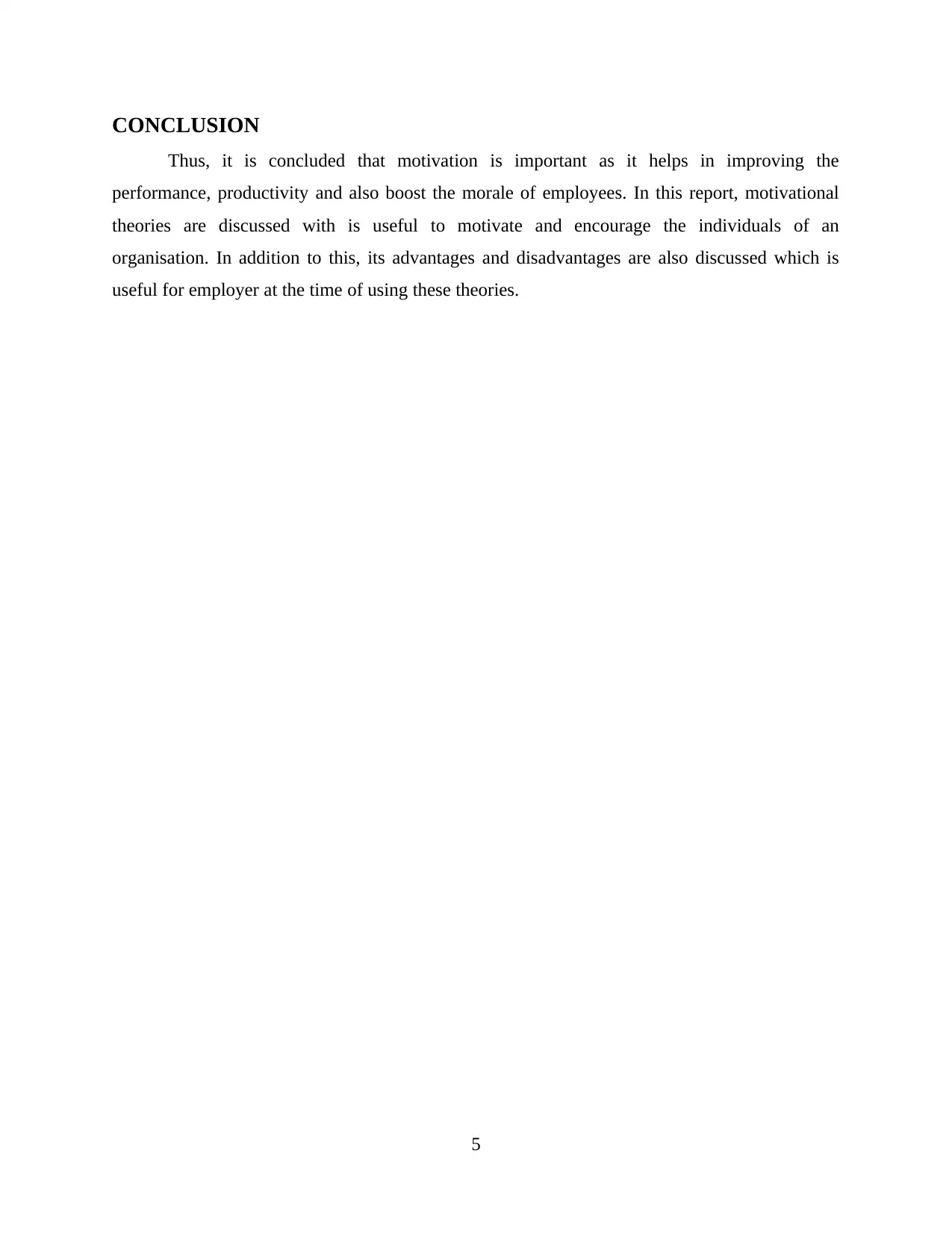
CONCLUSION
Thus, it is concluded that motivation is important as it helps in improving the
performance, productivity and also boost the morale of employees. In this report, motivational
theories are discussed with is useful to motivate and encourage the individuals of an
organisation. In addition to this, its advantages and disadvantages are also discussed which is
useful for employer at the time of using these theories.
5
Thus, it is concluded that motivation is important as it helps in improving the
performance, productivity and also boost the morale of employees. In this report, motivational
theories are discussed with is useful to motivate and encourage the individuals of an
organisation. In addition to this, its advantages and disadvantages are also discussed which is
useful for employer at the time of using these theories.
5
Paraphrase This Document
Need a fresh take? Get an instant paraphrase of this document with our AI Paraphraser
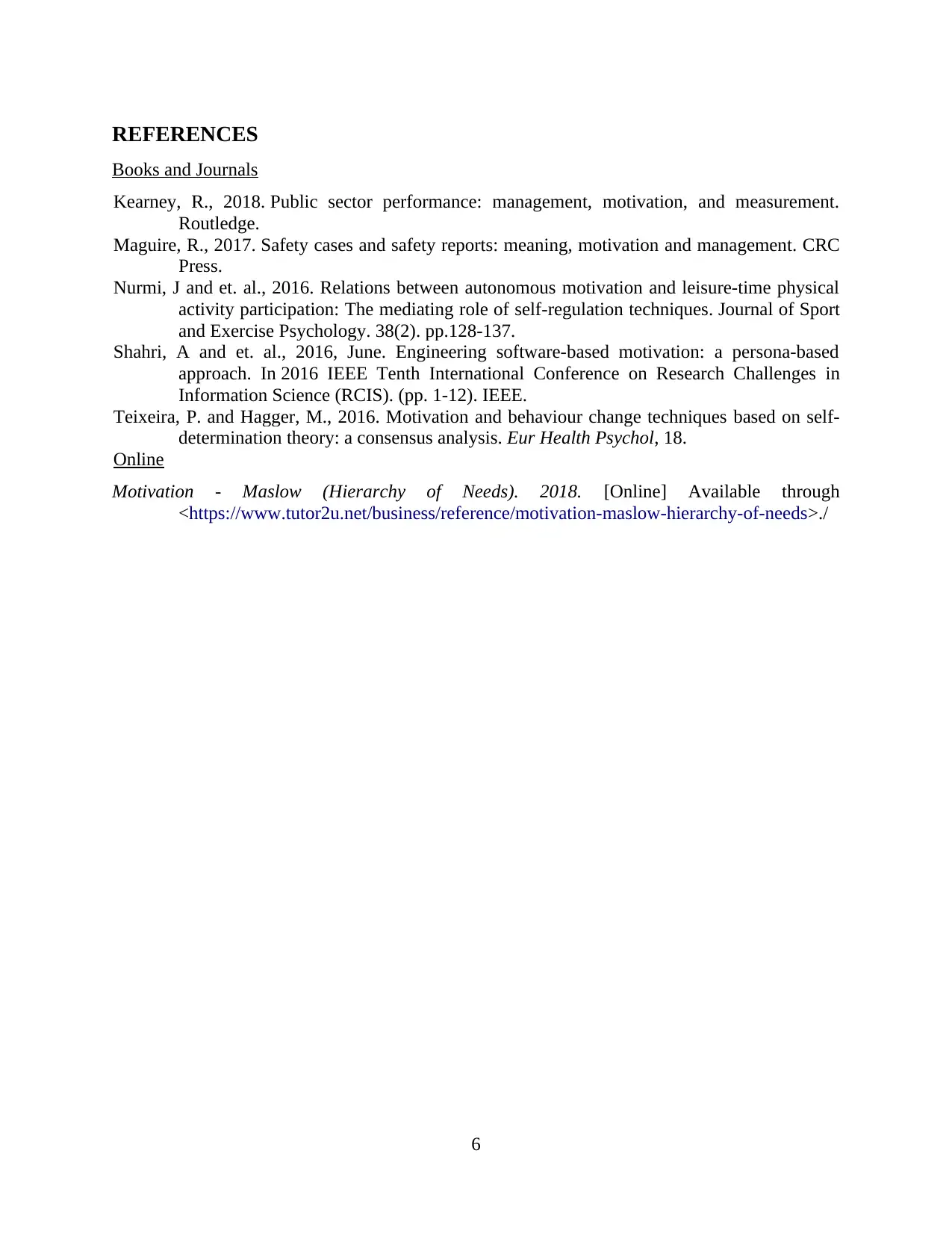
REFERENCES
Books and Journals
Kearney, R., 2018. Public sector performance: management, motivation, and measurement.
Routledge.
Maguire, R., 2017. Safety cases and safety reports: meaning, motivation and management. CRC
Press.
Nurmi, J and et. al., 2016. Relations between autonomous motivation and leisure-time physical
activity participation: The mediating role of self-regulation techniques. Journal of Sport
and Exercise Psychology. 38(2). pp.128-137.
Shahri, A and et. al., 2016, June. Engineering software-based motivation: a persona-based
approach. In 2016 IEEE Tenth International Conference on Research Challenges in
Information Science (RCIS). (pp. 1-12). IEEE.
Teixeira, P. and Hagger, M., 2016. Motivation and behaviour change techniques based on self-
determination theory: a consensus analysis. Eur Health Psychol, 18.
Online
Motivation - Maslow (Hierarchy of Needs). 2018. [Online] Available through
<https://www.tutor2u.net/business/reference/motivation-maslow-hierarchy-of-needs>./
6
Books and Journals
Kearney, R., 2018. Public sector performance: management, motivation, and measurement.
Routledge.
Maguire, R., 2017. Safety cases and safety reports: meaning, motivation and management. CRC
Press.
Nurmi, J and et. al., 2016. Relations between autonomous motivation and leisure-time physical
activity participation: The mediating role of self-regulation techniques. Journal of Sport
and Exercise Psychology. 38(2). pp.128-137.
Shahri, A and et. al., 2016, June. Engineering software-based motivation: a persona-based
approach. In 2016 IEEE Tenth International Conference on Research Challenges in
Information Science (RCIS). (pp. 1-12). IEEE.
Teixeira, P. and Hagger, M., 2016. Motivation and behaviour change techniques based on self-
determination theory: a consensus analysis. Eur Health Psychol, 18.
Online
Motivation - Maslow (Hierarchy of Needs). 2018. [Online] Available through
<https://www.tutor2u.net/business/reference/motivation-maslow-hierarchy-of-needs>./
6
1 out of 8
Related Documents
Your All-in-One AI-Powered Toolkit for Academic Success.
+13062052269
info@desklib.com
Available 24*7 on WhatsApp / Email
![[object Object]](/_next/static/media/star-bottom.7253800d.svg)
Unlock your academic potential
Copyright © 2020–2025 A2Z Services. All Rights Reserved. Developed and managed by ZUCOL.





